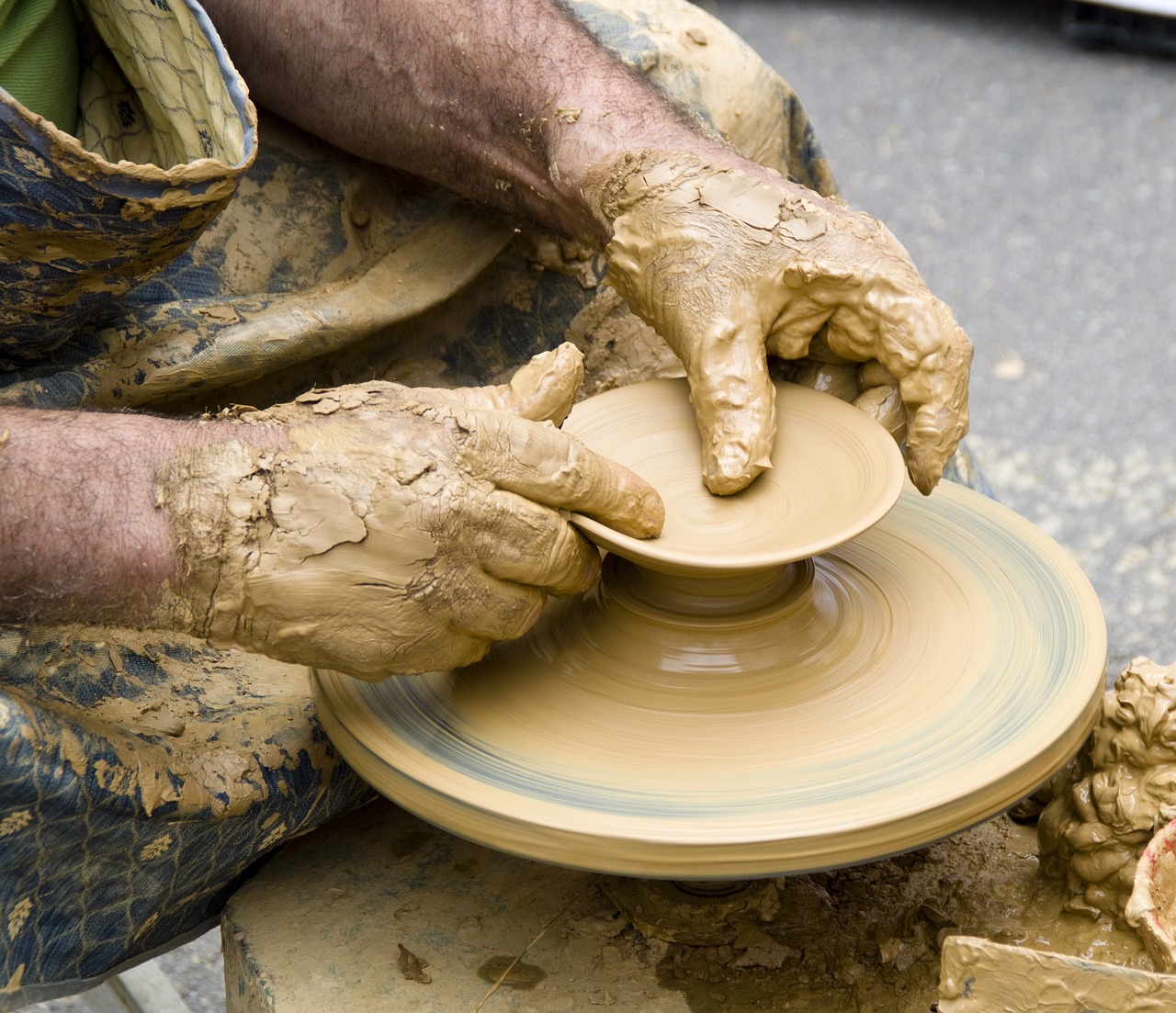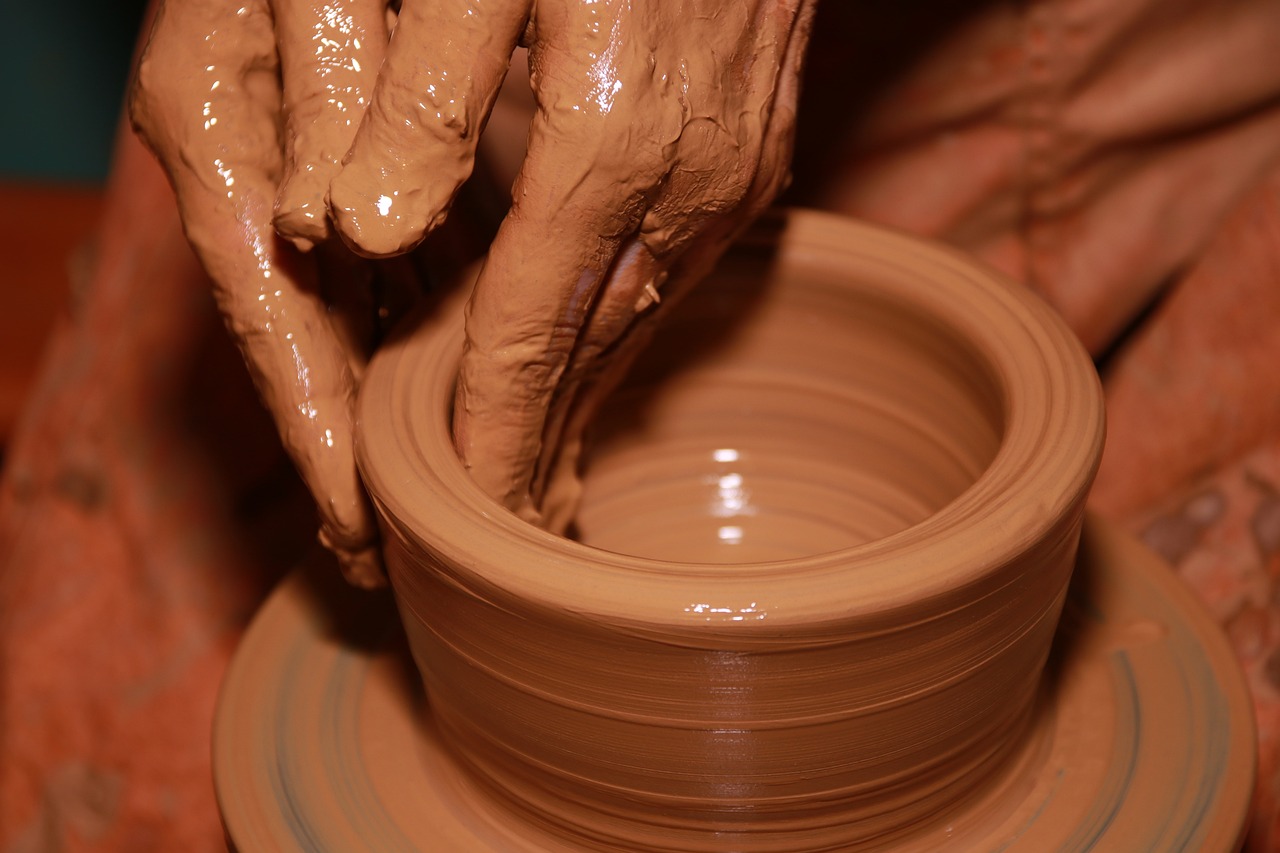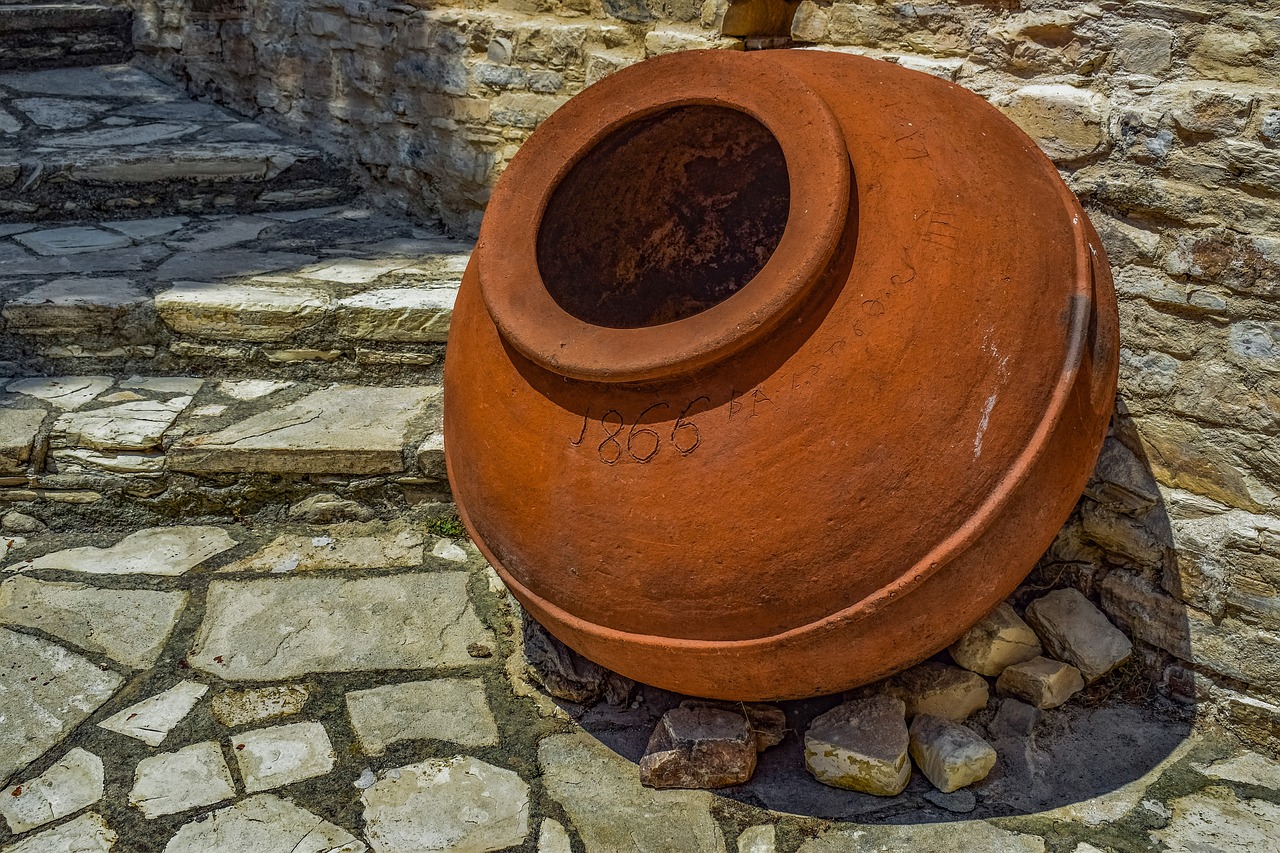Meet the Women Who Changed Pottery Forever
When you think of pottery, what comes to mind? Perhaps it's the delicate curves of a vase, the intricate designs on a plate, or the soothing feel of a handcrafted mug in your hands. But behind these beautiful creations lies a rich history shaped by influential women who have transformed pottery from a simple craft into a profound art form. These women, with their innovative techniques and artistic expressions, have not only redefined pottery but also paved the way for future generations of ceramic artists.
Imagine a world where pottery was just a utilitarian craft, devoid of creativity and personal touch. Thankfully, many remarkable women emerged as pioneers, challenging the norms and pushing the boundaries of what pottery could be. They brought their unique styles and techniques to the forefront, inspiring countless others to explore their own artistic potential. From the early days of pottery to the modern age, these women have demonstrated that pottery is not just about function; it’s about expression and storytelling.
Today, we celebrate these trailblazers and modern innovators who continue to shape the landscape of pottery. They are not only keeping traditional techniques alive but also embracing new materials and technologies. This fusion of old and new creates a vibrant tapestry of pottery that resonates with both history and contemporary aesthetics. It's a beautiful dance of creativity, where each piece tells a story of its own.
As we delve deeper into the world of pottery, we’ll uncover the inspiring journeys of these women, their motivations, and the profound impact they’ve had on the craft. From eco-conscious artists who prioritize sustainability to those who draw from their rich cultural backgrounds, the contributions of women in pottery are as diverse as the art itself. So, let’s embark on this journey together and meet the women who have changed pottery forever!
Discovering the groundbreaking women who laid the foundation for pottery as an art form is like opening a treasure chest filled with creativity and passion. These pioneers didn’t just create pottery; they revolutionized it. Their bold styles and techniques challenged traditional norms, encouraging others to think outside the box. One such artist is Maria Martinez, whose stunning blackware pottery from the Pueblo cultures of New Mexico captivated audiences worldwide. Her work not only showcased her cultural heritage but also set a new standard for artistic excellence in pottery.
Another notable figure is Lucie Rie, an Austrian-born potter who became a key player in the British ceramics scene. Rie's modernist approach and mastery of form and glaze have left an indelible mark on the pottery world. Her pieces are celebrated for their elegance and simplicity, proving that less can indeed be more. These women and many others like them have paved the way for future generations, inspiring a new wave of artists to explore their creativity in the realm of pottery.
Fast forward to today, and the landscape of pottery is more vibrant than ever, thanks to contemporary female potters who are redefining the craft. These artists are not afraid to experiment, utilizing new materials and technologies while staying true to the essence of pottery. Contemporary potters like Ayumi Horie and Kathy King are making waves with their innovative techniques and bold designs, proving that pottery can be both traditional and modern.
For instance, Ayumi Horie combines her Japanese heritage with contemporary aesthetics, creating pieces that resonate with both cultural significance and modern flair. Meanwhile, Kathy King’s playful approach to pottery often incorporates humor and social commentary, making her work not just beautiful but thought-provoking as well. These modern innovators are not just creating pottery; they are crafting conversations through their art.
In a world increasingly aware of environmental issues, many women potters are stepping up to the plate with a strong commitment to sustainability. These eco-conscious artists prioritize using eco-friendly materials and practices in their work, creating beautiful pottery that also promotes environmental awareness. They’re not just making art; they’re making a statement about the importance of caring for our planet.
One fascinating aspect of this movement is the innovative recycling methods employed by female potters. By repurposing materials that would otherwise end up in landfills, these artists are reducing waste and inspiring others to adopt sustainable practices in their own artistic processes. For example, some potters use recycled clay or incorporate found objects into their designs, showcasing that sustainability can be both creative and impactful.
Moreover, many women potters are turning to natural materials and traditional techniques to create unique, organic pottery that reflects their connection to nature. By using locally sourced clay, natural glazes, and traditional firing methods, they are not only honoring their heritage but also promoting a more sustainable approach to pottery. This return to nature in pottery is a beautiful reminder of the bond between art and the environment.
Diving deeper into the world of pottery, we find that the cultural backgrounds of women potters play a significant role in shaping their work. Each piece they create is infused with rich storytelling and symbolism, reflecting their heritage and personal experiences. This cultural influence adds layers of meaning to their pottery, making each piece a unique expression of identity.
Mentorship among women in pottery is crucial for fostering talent and building a sense of community. Established artists often take the time to support and inspire emerging talent, creating a collaborative environment where ideas can flourish. This network of support is vital for the growth of the pottery community, ensuring that the craft continues to evolve.
Workshops and collaborative projects led by female potters provide invaluable opportunities for skill-sharing and networking. These gatherings not only strengthen the bonds within the pottery community but also serve as a platform for emerging artists to learn from seasoned professionals. The exchange of ideas and techniques during these workshops often leads to exciting new directions in pottery.
In today’s digital age, social media and online platforms have revolutionized the way women potters connect and share their work. These online communities create a global network of support and inspiration, allowing artists to showcase their creations, exchange ideas, and collaborate across borders. Whether through Instagram, Facebook groups, or dedicated pottery forums, these platforms have become vital for fostering connections among women in pottery.
Q: What is the significance of women in pottery?
A: Women have played a pivotal role in transforming pottery into a respected art form, bringing unique perspectives, techniques, and cultural influences to the craft.
Q: How are modern female potters redefining the craft?
A: Modern female potters are using innovative materials and technologies while honoring traditional techniques, creating pieces that blend the old with the new.
Q: Why is sustainability important in pottery?
A: Sustainability is crucial in pottery as it promotes environmental responsibility and reduces waste, ensuring that the craft can be enjoyed by future generations.
Q: How can I get involved in the pottery community?
A: You can get involved by attending workshops, joining local pottery classes, or participating in online communities to connect with other artists and enthusiasts.

The Pioneers of Pottery
When we think about the world of pottery, it’s easy to overlook the remarkable women who have been instrumental in shaping this art form. From ancient times to the present day, these pioneers have not only crafted stunning pieces but have also challenged the norms of their time, paving the way for future generations of ceramic artists. Their stories are filled with passion, innovation, and a relentless pursuit of artistic expression.
One of the most notable figures in the history of pottery is Maria Martinez, a Native American potter from the Pueblo of San Ildefonso in New Mexico. Her unique blackware pottery, made using traditional methods passed down through generations, gained international acclaim. Maria’s work not only showcased her incredible talent but also highlighted the importance of cultural heritage in the art of pottery. She transformed the perception of Native American pottery from mere craft to a respected art form, inspiring countless artists worldwide.
Another trailblazer is Lucie Rie, an Austrian-born potter who moved to England before World War II. Rie's innovative approach to form and glaze revolutionized studio pottery. She combined traditional techniques with modern aesthetics, creating pieces that were both functional and sculptural. Her work is a testament to how innovation can arise from a blend of cultures and ideas. Rie's influence can be seen in the works of many contemporary potters who strive to push the boundaries of what pottery can be.
As we delve deeper into the realm of pottery, we also encounter the extraordinary contributions of women like Beatrice Wood, who is often referred to as the "Mama of Dada." Wood was not only a potter but also an artist and writer who embraced the Dada movement. Her playful and whimsical approach to ceramics challenged traditional aesthetics, encouraging others to explore their creativity without limitations. Through her art, she invited us to see the world through a different lens, making pottery a medium for personal expression and storytelling.
These pioneering women did not just create beautiful pottery; they redefined the very essence of the craft. They faced numerous challenges, including societal expectations and gender biases, yet their determination and talent shone through. The impact of their work is felt today, as modern potters continue to draw inspiration from their innovative techniques and artistic philosophies.
In addition to their artistic contributions, these women also played a crucial role in mentoring the next generation of potters. They established workshops, wrote books, and shared their knowledge, ensuring that the art of pottery would continue to evolve. Their legacy is a reminder that creativity knows no bounds and that the stories of women in pottery are still being written today.
As we celebrate the pioneers of pottery, it’s essential to recognize that their influence extends beyond the clay. They have shaped the narrative of what pottery means in our society, transforming it from a simple craft into a powerful form of artistic expression. Their journeys are a source of inspiration for all of us, encouraging us to embrace our creativity and challenge the status quo.
- Who are some famous women potters? Some notable women potters include Maria Martinez, Lucie Rie, and Beatrice Wood, who have all made significant contributions to the art of pottery.
- How did women influence the pottery craft? Women have played a crucial role in redefining pottery by introducing innovative techniques, challenging traditional norms, and mentoring emerging artists.
- What materials do women potters typically use? Many women potters utilize a range of materials, including natural clay, glazes, and eco-friendly substances, to create their unique pieces.

Modern Innovators
When we think about pottery, it’s easy to envision traditional techniques and familiar forms, but the world of ceramics has evolved dramatically, especially thanks to the **incredible women** who are leading the charge as modern innovators. These talented artists are not just creating beautiful pieces; they are also pushing the boundaries of what pottery can be. By embracing **new materials**, experimenting with **cutting-edge technologies**, and weaving in their unique personal narratives, these women are redefining the craft for a new generation.
Take, for instance, the work of contemporary potters who are integrating technology into their art. With the advent of 3D printing, some female artists are exploring the possibilities of creating intricate designs that would be nearly impossible to achieve by hand. This fusion of traditional craftsmanship and modern technology allows for a level of **precision** and **creativity** that has the potential to change the landscape of pottery forever. Imagine a piece that not only looks stunning but also incorporates elements that tell a story about the artist's journey, their heritage, or even their personal experiences.
Moreover, many of these modern innovators are committed to **sustainability**. They are consciously choosing materials that are eco-friendly, which not only helps the environment but also resonates with consumers who are increasingly aware of their impact on the planet. For example, artists are using recycled clay and natural glazes to create pieces that are as beautiful as they are responsible. This commitment to sustainability reflects a broader trend in the arts where the environmental impact of materials is becoming a primary consideration.
Let's take a look at a few examples of these remarkable women who are making waves in the pottery world:
| Artist Name | Innovative Technique | Material Used |
|---|---|---|
| Sarah Wong | 3D Printed Pottery | Recycled Plastic |
| Emily Chen | Natural Glazing | Local Clay |
| Isabella Martinez | Mixed Media | Eco-friendly Paints |
These artists exemplify the spirit of modern pottery by blending **innovation** with **tradition**. They are not just creating functional items; they are crafting pieces of art that provoke thought and inspire dialogue. Their work often tells stories that reflect their cultural backgrounds and personal experiences, creating a deeper connection between the artist and the audience.
In conclusion, the modern innovators in pottery are a testament to the evolving nature of this craft. They remind us that pottery is not just about shaping clay; it’s about **expressing identity**, **challenging norms**, and **embracing change**. As these women continue to push the boundaries, they are paving the way for future generations of ceramic artists, ensuring that the world of pottery remains vibrant, relevant, and full of possibilities.
- What materials are modern potters using today? Many modern potters are incorporating eco-friendly materials, recycled clay, and natural glazes into their work.
- How has technology influenced pottery? Technology, such as 3D printing, has allowed artists to create intricate designs and forms that were previously unattainable.
- What is the significance of sustainability in modern pottery? Sustainability is crucial as it promotes environmental responsibility while meeting the growing consumer demand for eco-conscious products.

Eco-Conscious Artists
In a world that increasingly values sustainability, in the pottery community are leading the charge towards a greener future. These remarkable women are not only crafting beautiful pieces but are also making a significant impact by prioritizing the environment in their artistic practices. Imagine walking into a gallery where every piece tells a story—not just of art, but of responsibility and care for our planet. This is the vision these artists strive for, blending creativity with ecological mindfulness.
One of the most inspiring aspects of these eco-conscious potters is their commitment to using eco-friendly materials. Many of them have turned to locally sourced clays and natural glazes, which not only reduce their carbon footprint but also celebrate the earth's resources. For instance, some artists utilize reclaimed materials, breathing new life into what would otherwise be waste. This practice not only minimizes waste but also adds a unique character to each piece, making every creation a testament to innovation and sustainability.
Moreover, these artists often employ traditional techniques that have been passed down through generations. By embracing methods that are less reliant on modern technology and more on human touch, they connect with the past while paving the way for the future. This approach not only honors the art of pottery but also serves as a reminder of the importance of environmental stewardship. In their hands, clay transforms into a medium for change, encouraging others in the community to adopt similar practices.
To highlight the impact of eco-conscious artists, consider the following table that showcases some of the materials and techniques they use:
| Material/Technique | Description | Environmental Benefit |
|---|---|---|
| Reclaimed Clay | Clay collected from previous projects or discarded pottery. | Reduces waste and promotes resourcefulness. |
| Natural Glazes | Glazes made from minerals and plants rather than synthetic chemicals. | Less harmful to the environment and safer for health. |
| Traditional Handbuilding | Using hand techniques instead of electric tools. | Lower energy consumption and a more personal touch. |
In addition to their material choices, eco-conscious artists often engage in community initiatives that promote environmental awareness. They might host workshops that teach sustainable practices or participate in local art fairs that focus on eco-friendly art. This not only enhances their visibility but also inspires others to think critically about their own practices. The ripple effect of their work is profound, as they encourage a culture of sustainability within the pottery community and beyond.
Ultimately, the work of these eco-conscious artists serves as a powerful reminder that art can be a vehicle for change. By weaving sustainability into the fabric of their creations, they challenge us to reconsider our relationship with the environment. So, the next time you admire a piece of pottery, take a moment to reflect on the story behind it—the artist's dedication to the earth, the innovative techniques they employed, and the future they envision for both their craft and our world.
- What materials do eco-conscious potters typically use? Eco-conscious potters often use reclaimed clay, natural glazes, and locally sourced materials to minimize their environmental impact.
- How can I support eco-conscious pottery artists? You can support them by purchasing their work, attending their workshops, and spreading awareness about sustainable practices in art.
- Are there specific techniques that eco-conscious artists prefer? Many prefer traditional handbuilding techniques, which consume less energy compared to electric tools.

Recycling Techniques
In the ever-evolving world of pottery, have emerged as a powerful tool for female potters who aim to minimize waste while maximizing creativity. These innovative artists are not just shaping clay; they are also reshaping the very principles of sustainability in their craft. Imagine a world where every broken piece of pottery tells a story, where discarded materials are transformed into stunning works of art. This is the reality that many women potters have embraced, turning what was once seen as waste into a canvas for their imagination.
One of the most fascinating aspects of recycling in pottery is the variety of methods employed by these talented women. For instance, some potters utilize scrap clay—the remnants from previous projects that would otherwise be thrown away. Instead of letting this clay go to waste, they knead it back into new forms, creating unique textures and colors that can’t be replicated with fresh clay. This not only conserves resources but also adds character to each piece, as every lump of recycled clay carries a history of its own.
Another popular technique involves the use of found objects. Women potters often incorporate materials like broken tiles, glass shards, or even industrial waste into their creations. By doing this, they not only reduce waste but also introduce unexpected elements into their designs. For example, a potter might use shattered glass to create a mosaic effect on a vase, turning what was once considered trash into a breathtaking centerpiece. This fusion of materials not only showcases their artistic vision but also challenges the conventional boundaries of pottery.
Furthermore, these artists are not just focused on their own practices; they often share their knowledge and techniques with others. Many host workshops that teach aspiring potters how to embrace recycling in their work. These sessions often cover:
- Identifying recyclable materials
- Techniques for repurposing clay
- Creating unique glazes from recycled substances
Such community engagement fosters a culture of sustainability, encouraging artists to think critically about their material choices and the impact they have on the environment.
In addition to their artistic practices, many women potters also advocate for environmental responsibility within the broader art community. They often participate in exhibitions and events that highlight the importance of sustainability in art. By showcasing their recycled pieces, they not only promote their work but also spread awareness about the need for eco-friendly practices in pottery and beyond. This commitment to sustainability is a testament to their belief that art can be a force for positive change.
Ultimately, the recycling techniques employed by female potters are not just about reducing waste; they are about redefining the narrative of what pottery can be. By infusing their work with sustainability, these artists inspire a new generation of creators to think outside the box, to see potential where others see waste. As they continue to innovate and challenge traditional norms, they pave the way for a more sustainable future in the world of pottery.
- What materials can be recycled in pottery? Many materials can be recycled, including scrap clay, broken pottery, and found objects like glass and metal.
- How do recycling techniques affect the final product? Recycling techniques can add unique textures and colors to the pottery, making each piece one-of-a-kind.
- Are there workshops available for learning recycling techniques? Yes, many female potters offer workshops that focus on sustainable practices and recycling in pottery.

Natural Materials
In the world of pottery, the choice of materials is crucial, and many female potters are embracing the beauty and sustainability of . These artisans are not just creating pottery; they are crafting pieces that tell a story, reflecting their deep connection to the earth and the environment. By using locally sourced clay, natural glazes, and organic textures, these women are redefining what it means to create art that is both beautiful and responsible.
Natural materials bring a unique quality to pottery that manufactured materials simply cannot replicate. For instance, when potters use clay that has been dug from the ground, it often retains the character of the landscape from which it came. This connection to place adds a layer of meaning to each piece, allowing the artist to share a part of their environment with the world. Moreover, the use of natural materials can enhance the aesthetic appeal of pottery, creating variations in color and texture that are simply stunning.
Some of the most commonly used natural materials in pottery include:
- Clay: Sourced from riverbeds, hillsides, or even backyards, natural clay varies in color and composition, providing a rich palette for artists.
- Natural Glazes: These can be made from minerals found in the earth, such as ash from wood fires or iron oxide, which can create beautiful, earthy tones.
- Organic Additives: Some potters incorporate materials like crushed seashells or sand to add texture and interest to their work.
By prioritizing natural materials, these potters are also making a statement about sustainability. In a time when environmental awareness is more important than ever, their choice to work with what the earth provides is a powerful reminder of our responsibility to the planet. Many of these artists engage in practices that minimize waste, such as using every bit of clay they can and recycling materials whenever possible.
Furthermore, the process of working with natural materials often leads to a more mindful approach to creation. Potters who embrace this philosophy tend to develop a deeper understanding of their craft, learning to appreciate the nuances of their materials. This connection not only enhances their skills but also fosters a sense of respect for the earth, pushing them to consider the impact of their work on the environment.
In conclusion, the use of natural materials in pottery is not just a trend; it’s a movement led by passionate women who are committed to creating art that honors the earth. By blending traditional techniques with modern sensibilities, these potters are paving the way for a more sustainable future in the craft, inspiring others to follow suit. As we celebrate their creativity and commitment, we are reminded that every piece of pottery can carry with it a piece of nature, a story, and a promise to cherish our planet.
Q: What are natural materials in pottery?
A: Natural materials in pottery refer to substances sourced from the environment, such as clay, natural glazes, and organic additives, which are used to create ceramic pieces with unique characteristics.
Q: Why is it important to use natural materials?
A: Using natural materials promotes sustainability, reduces environmental impact, and allows potters to create pieces that reflect their connection to nature and their surroundings.
Q: How do natural materials affect the final product?
A: Natural materials can enhance the aesthetic appeal of pottery by providing unique textures and colors that are often not achievable with manufactured materials.
Q: Can anyone use natural materials in pottery?
A: Yes! Anyone interested in pottery can explore the use of natural materials, though it may require some research and experimentation to find the right sources and techniques.

Cultural Influences
The world of pottery is as diverse as the cultures that inspire it. Women potters from various backgrounds infuse their work with rich stories and deep-rooted traditions, transforming clay into a canvas of cultural expression. Each piece they create tells a story, reflecting the values, beliefs, and aesthetics of their heritage. For instance, potters from Indigenous communities often incorporate traditional motifs and techniques passed down through generations, ensuring that their cultural narratives are preserved and celebrated.
Moreover, the influence of cultural elements can be seen in the choice of materials and forms. Many women potters draw from their surroundings, utilizing local resources that resonate with their cultural identity. This connection to place not only enriches their work but also fosters a sense of belonging and pride. As they mold their creations, they are not just shaping clay; they are shaping their cultural legacy. The stories behind these pieces are often as captivating as the work itself, providing insight into the potter's journey and the cultural significance of their art.
In addition to traditional techniques, contemporary female potters are also finding ways to blend modern aesthetics with cultural influences. For example, a potter might use traditional glazing methods but apply them to modern forms, creating a dialogue between the past and the present. This fusion of styles not only broadens the appeal of their work but also invites viewers to appreciate the complexities of cultural identity in a globalized world.
To better understand the impact of cultural influences on pottery, let's take a look at some notable examples:
| Potter | Cultural Background | Influence on Work |
|---|---|---|
| Maria Martinez | Pueblo Native American | Revived traditional black-on-black pottery techniques |
| Lucie Rie | Austrian-British | Blended European and Japanese aesthetics in her ceramics |
| Sharon McCauley | Scottish | Incorporates Celtic symbols and stories into her pieces |
These examples illustrate how cultural influences are not merely decorative but are deeply intertwined with the identity and purpose of the work. By embracing their heritage, these women potters not only honor their roots but also inspire others to explore their own cultural narratives through the medium of clay. In a world where globalization often threatens the uniqueness of individual cultures, these artists serve as vital stewards of tradition, reminding us of the beauty and significance of cultural diversity in the arts.
Ultimately, the cultural influences in pottery reflect a broader narrative about identity, belonging, and the power of storytelling. Each piece crafted by these talented women is a testament to their journey, their culture, and their unwavering commitment to preserving and celebrating the art of pottery.
- What role does culture play in pottery? Culture significantly influences the aesthetics, techniques, and materials used in pottery, allowing artists to express their heritage and identity.
- How can pottery reflect personal stories? Potters often incorporate personal experiences, cultural symbols, and traditional narratives into their work, making each piece unique and meaningful.
- Are there modern influences in traditional pottery? Yes, many contemporary potters blend traditional techniques with modern designs, creating a fusion that respects the past while embracing the present.

Mentorship and Community
In the world of pottery, the bond between artists often extends beyond mere collaboration; it evolves into a profound mentorship that shapes the future of the craft. Women potters have long recognized the importance of supporting one another, creating a nurturing environment where creativity flourishes. This sense of community is not just beneficial; it's essential. When established artists take the time to mentor emerging talent, they pass down invaluable knowledge, techniques, and artistic philosophies that might otherwise be lost. It's like planting seeds in a garden—each mentor nurtures a budding artist, helping them grow into their own unique style.
Through various workshops, mentorship programs, and collaborative projects, women in pottery are fostering a culture of sharing and learning. Imagine a vibrant studio filled with laughter, clay, and the sound of wheels spinning—this is where ideas are exchanged and friendships are formed. These gatherings not only enhance skills but also strengthen the bonds among artists, creating a tight-knit community that celebrates each other's successes. The collective energy in these spaces is electric, sparking inspiration and pushing boundaries.
One of the most exciting aspects of this mentorship culture is the diversity it brings to the pottery community. Women from different backgrounds and experiences come together, sharing their unique perspectives and techniques. This melting pot of ideas results in innovative works that challenge traditional forms and celebrate cultural heritage. As these artists collaborate, they create a rich tapestry of creativity that resonates with audiences worldwide.
Moreover, the rise of social media has revolutionized how these communities connect. Platforms like Instagram and Facebook have become vital tools for women potters to showcase their work, share their journeys, and support one another. Online groups and forums provide a space for discussions, advice, and encouragement, breaking down geographical barriers. This digital landscape allows artists to find their tribe, no matter where they are in the world.
To illustrate the impact of mentorship and community in pottery, let's take a look at some key aspects:
| Aspect | Description |
|---|---|
| Skill Development | Established artists provide guidance on techniques, helping newcomers refine their craft. |
| Networking Opportunities | Workshops and events create connections that can lead to future collaborations. |
| Emotional Support | Artists share challenges and triumphs, fostering a supportive environment. |
| Diversity of Perspectives | Women from various backgrounds bring unique influences to the craft. |
In essence, the mentorship and community among women potters is a beautiful testament to the power of collaboration and support. As they continue to uplift one another, they are not just shaping their individual paths but also paving the way for future generations of ceramic artists. It's a cycle of inspiration that ensures the craft of pottery remains vibrant and evolving, much like the clay they mold with their hands.
- What is the role of mentorship in pottery? Mentorship in pottery involves experienced artists guiding newcomers, sharing techniques, and fostering a supportive environment for growth.
- How can I find a pottery mentor? Look for local pottery studios, workshops, or online communities where you can connect with established artists who may be willing to mentor.
- What are the benefits of joining a pottery community? Joining a pottery community offers networking opportunities, skill development, emotional support, and exposure to diverse artistic perspectives.

Workshops and Collaborations
In the vibrant world of pottery, play a pivotal role in nurturing creativity and fostering community among women potters. These gatherings are not just about shaping clay; they are about shaping connections. When women come together, they share not only their skills but also their stories, experiences, and dreams. Imagine a cozy studio filled with laughter, the sound of tools clinking, and the rich aroma of wet clay. This is where friendships are forged, and artistic boundaries are pushed.
Workshops often serve as a melting pot of ideas, where seasoned potters mentor newcomers, guiding them through the intricacies of techniques like glazing, throwing, and hand-building. For many women, these workshops are a safe haven, a place to explore their artistic identity without judgment. They can experiment with new styles and materials, often leading to unexpected breakthroughs in their work. It's fascinating how a simple workshop can ignite a spark of inspiration, leading to the creation of pieces that tell profound stories.
Moreover, collaborations among female potters can yield stunning results. When artists from different backgrounds come together, the fusion of their unique perspectives creates something truly special. For instance, a collaborative project might involve a sculptor working alongside a traditional potter, blending modern aesthetics with age-old techniques. This synergy not only enhances their individual practices but also broadens their artistic horizons. The beauty of collaboration is that it encourages risk-taking and innovation, allowing artists to step outside their comfort zones.
Many workshops also emphasize the importance of sustainability in pottery. Female potters are increasingly incorporating eco-friendly practices into their work, and workshops provide an excellent platform for sharing these methods. Participants can learn about sourcing local materials, using natural glazes, and implementing recycling techniques in their pottery. This focus on sustainability not only enhances their craft but also promotes a sense of responsibility towards the environment, creating a ripple effect that inspires others in the community.
In addition to hands-on workshops, many female potters are leveraging online platforms to facilitate virtual collaborations. This digital shift has opened up a world of opportunities, allowing potters from different corners of the globe to connect and share their expertise. Virtual workshops can feature live demonstrations, Q&A sessions, and even collaborative projects that transcend geographical boundaries. The internet has transformed the pottery landscape, making it easier than ever for women to unite, learn, and grow together.
Ultimately, workshops and collaborations are more than just educational experiences; they are a celebration of the female spirit in pottery. They embody the essence of community, where women uplift one another and create an environment rich with creativity and support. As these potters continue to inspire each other, they pave the way for future generations, ensuring that the legacy of women in pottery remains vibrant and influential.
- What types of workshops are available for women potters?
There are various workshops focusing on different techniques, from wheel throwing to hand-building and glazing. Many also emphasize sustainability and eco-friendly practices. - How can I find a pottery workshop near me?
Local art centers, community colleges, and pottery studios often host workshops. Additionally, searching online platforms can lead you to virtual workshops. - Can I participate in a workshop if I am a beginner?
Absolutely! Most workshops are designed to accommodate all skill levels, making them perfect for beginners looking to learn. - What are the benefits of collaborating with other potters?
Collaborating allows you to share ideas, techniques, and inspiration, leading to innovative work that you might not create on your own.

Online Communities
The digital age has opened up a whole new world for women potters, allowing them to connect, collaborate, and share their passion for ceramics like never before. have become vibrant hubs where creativity flourishes and ideas are exchanged, creating a sense of belonging among artists from diverse backgrounds. Imagine a virtual studio where potters from all corners of the globe gather to showcase their work, share techniques, and inspire one another. This is the power of online platforms!
Social media platforms such as Instagram, Facebook, and Pinterest have revolutionized how potters interact. For instance, Instagram serves as a visual diary where potters can post stunning images of their latest creations, engage with followers, and even sell their work. The use of hashtags like #pottery, #ceramics, and #womeninart allows artists to reach a wider audience, attracting potential customers and fellow artisans alike. It's like having a global gallery at your fingertips!
Moreover, many potters have formed dedicated groups on platforms like Facebook, where they can ask questions, seek advice, and share resources. These groups often feature discussions on various topics, including:
- Techniques for glazing and firing
- Reviews of pottery tools and materials
- Opportunities for exhibitions and markets
- Tips for balancing art with business
These online communities not only foster learning but also promote mentorship. Established artists often take the time to offer guidance to newcomers, sharing their experiences and insights. This kind of support can be invaluable, especially for those just starting their pottery journey. In essence, it's like having a big sister in the craft who is always there to lend a helping hand.
In addition to social media, various websites and forums dedicated to ceramics provide a platform for women potters to connect. For example, platforms like Pottery Heads and Ceramic Arts Network feature articles, tutorials, and forums specifically tailored to the pottery community. These resources are treasure troves of information, allowing potters to deepen their knowledge and refine their skills.
Furthermore, online marketplaces such as Etsy have empowered women potters to showcase and sell their work directly to consumers. This not only helps to promote their artistry but also allows them to build a brand and establish a loyal customer base. It's a fantastic way to turn a passion into a sustainable business!
As we look to the future, it's clear that online communities will continue to play a crucial role in shaping the pottery landscape. They provide a space for collaboration, innovation, and support, ensuring that the legacy of women potters will thrive for generations to come. So, whether you're a seasoned artist or just dipping your toes into the world of ceramics, know that you're never alone on this journey. The online pottery community is here to inspire you, challenge you, and celebrate your unique contributions to the craft!
| Question | Answer |
|---|---|
| How can I find online pottery communities? | Start by searching for pottery-related groups on social media platforms like Facebook or Instagram. You can also explore dedicated pottery forums and websites. |
| Are there any costs associated with joining online pottery communities? | Most online communities are free to join, but some may offer premium memberships for additional resources or workshops. |
| Can I sell my pottery online? | Yes! Platforms like Etsy allow you to set up your own shop and sell your pottery directly to customers. |
Frequently Asked Questions
- Who are some of the most influential women in pottery?
Throughout history, many women have made significant contributions to the art of pottery. Pioneers like Lucie Rie and Beatrice Wood challenged traditional pottery norms with their innovative techniques and unique styles. Their work not only inspired their contemporaries but also paved the way for future generations of female ceramic artists.
- How are modern female potters redefining the craft today?
Modern female potters are embracing new materials and technologies while remaining rooted in traditional practices. They experiment with different forms, textures, and colors, creating pieces that resonate with both contemporary aesthetics and historical significance. This fusion of old and new is what makes their work so captivating!
- What role does sustainability play in pottery?
Sustainability is becoming increasingly important in the pottery community. Many women potters prioritize eco-friendly materials and practices, such as using recycled clay or natural glazes. By adopting these methods, they not only reduce waste but also promote environmental awareness within the art community.
- What are some innovative recycling techniques used by female potters?
Female potters are finding creative ways to repurpose materials, such as transforming broken pots into new creations or using scraps from previous projects. These innovative recycling techniques not only minimize waste but also inspire others to think outside the box and adopt sustainable practices in their own work.
- How do cultural influences shape the work of women potters?
Cultural backgrounds play a significant role in the pottery created by women artists. Their heritage often informs their choice of motifs, techniques, and storytelling within their pieces. This rich tapestry of influences adds depth and meaning to their work, making it a reflection of their personal and cultural identities.
- What is the importance of mentorship in the pottery community?
Mentorship is vital in the pottery community, especially among women. Established artists often support and inspire emerging talent, creating a nurturing environment for growth. This collaborative spirit fosters a sense of belonging and encourages the sharing of skills and experiences, which ultimately strengthens the craft as a whole.
- How can I get involved in pottery workshops or collaborations?
Many female potters host workshops and collaborative projects, which are great opportunities to learn and connect with others in the community. You can find these events through local art centers, pottery studios, or even social media platforms where artists share their upcoming projects. Don't be shy—jump in and start creating!
- How has social media impacted the pottery community?
Social media has revolutionized the way women potters connect and share their work. Platforms like Instagram and Pinterest allow artists to showcase their creations to a global audience, fostering a network of support and inspiration. This digital landscape not only helps promote their craft but also builds a sense of community among potters worldwide.



















